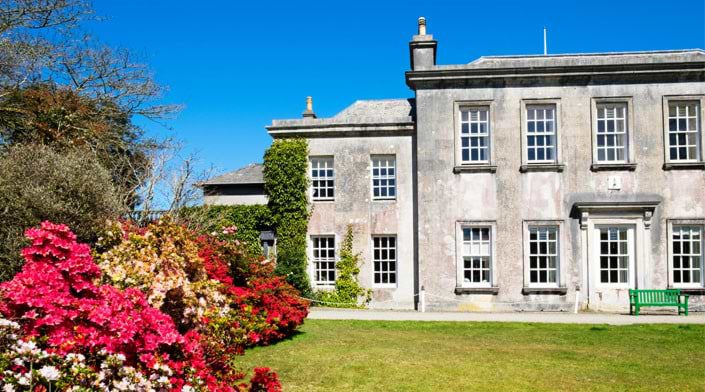
© Kevin Britland / Alamy Stock Photo
The beautiful Trewithen House and Gardens is undoubtedly the jewel in picturesque Cornwall's crown. The name Trewithen means "house of the trees" - and this couldn't be more appropriate, as the estate boasts 30 acres of Grade II listed woodland gardens and more than 200 acres of parkland. The grounds of the Georgian country house in Probus, Cornwall, are home to some of the most stunning magnolia trees in the world, creating a spectacle of pink and white blooms. In fact, one of the highlights of the gardens is the finest cultivated magnolia in the UK, the Magnolia Campbellii subspecies, Mollicomata. It towers more than 65 feet high and was originally introduced from China, creating a glorious spectacle when it flowers in Spring. Located half-way down the south lawn, the mighty magnolia dominates the landscape all year round, but particularly in spring. Grade 1 listed, Trewithen House is recognised as one of the most elegant and fine examples of 18th-century architecture in Cornwall. The combination of the historic house and breath-taking gardens makes Trewithen one of the county's most popular visitor destinations. Trewithen history Phillip Hawkins, a wealthy landowner and attorney, bought the estate back in 1715 and commissioned top London architect Thomas Edwards to build the house and lay out the park. He bequeathed the estate to his nephew, Thomas Hawkins, who engaged architect Sir Robert Taylor's services to redesign Trewithen House and landscape the gardens. Many trees were planted and the vistas around the house were established. Hawkins left the estate to his son, Christopher, a businessman who opened new tin and copper mines around Cornwall, established clay mining near St Austell, rebuilt Pentewan harbour and St Ives' great breakwater, and built new schools. Following Christopher’s death in 1829, Trewithen passed to his brother, John Hawkins, who planted more magnificent trees, such as the famous Holm oaks. John left the estate to his son, Henry, who then bequeathed Trewithen to his nephew, John Johnstone, in 1903. John, in turn, left the estate to his son, George Johnstone, who significantly developed the gardens. He also sponsored expeditions to search for new species of plants in China and the Himalayas, with many of the new varieties being introduced at Trewithen. The current owner of the estate is George's grandson, Michael Galsworthy, who went to live in Trewithen House with his family in 1980. He has planted more than 30,000 additional trees in the surrounding woodlands. Garden highlights The south-facing great glade is revered as a masterpiece of landscape gardening. Developed between 1910 and 1932, this was the era of the great plant-hunting expeditions when many unusual seed collections from far-flung corners of the globe were successfully cultivated at the estate. With countryside views to die for, you can stroll around the woodland gardens and through the 200 acres of surrounding parkland, full of secluded areas and magnificent flora and fauna. There are many fascinating trees and shrubs off the beaten track. Other highlights include the magnificent Kashmir cypress, the rhododendron "frill" that was raised at Trewithen as a hybrid, the amazing Maidenhair tree and the well-established, apricot-flowered "Rhododendron Alison Johnstone", bred by George Johnstone in honour of his wife - the recipient of a Royal Horticultural Society Award of Merit in 1945. Alison was the current owner Michael Galsworthy's grandmother. During his grandparents' time, there was a real horticultural "buzz" at Trewithen and famous gardeners were always visiting to enjoy a garden tour and see the new blooms. Wildlife haven Head gardener Gary Long has created a wildlife garden featuring specially arranged elements that have been installed to attract indigenous animals and insects. Features include Buddleia to attract butterflies, log piles for hedgehogs and insects, a natural hay meadow for mice, wildflowers, dragonflies and other insects, a "bee hotel" made from a bundle of bamboo, a barn owl box and bat boxes. One part of the garden has a frog-shaped pond, designed by pupils of Probus Primary School in a competition run by the head gardener. The garden has successfully attracted a variety of native Cornish wildlife. Red squirrels Trewithen has also welcomed back one of the UK's most threatened species of mammal, the red squirrel, to its garden in recent years. This is the first time in 60 years that red squirrels have lived at Trewithen. They have been largely wiped out by the grey squirrel across the UK since the 1950s. In March 2012, two female red squirrels were delivered to Trewithen and were joined by a male donated by Prince Charles in July 2012. The prince is president of the Red Squirrel Survival Trust. Red squirrels at Trewithen are only the second breeding population in Cornwall. The offspring produced by the red squirrels at Trewithen will eventually be released in other areas of the country where there are already red squirrels in the wild. Two baby red squirrels were born in 2014. The population is housed in a walk-through enclosure by the Walled Garden. If you're planning a visit to Trewithen House and Gardens, the estate is open seven days a week, from 10am to 4.30pm, until 30th June. The Tea Shed, the estate's tea rooms, selling fresh local Cornish produce, has extended its opening hours until 27th October. Immensely proud of our heritage, MA Grigg’s country store is located in the heart of St Austell. We stock many top brands for enjoying the glorious Cornish countryside. Please contact us for further information.




